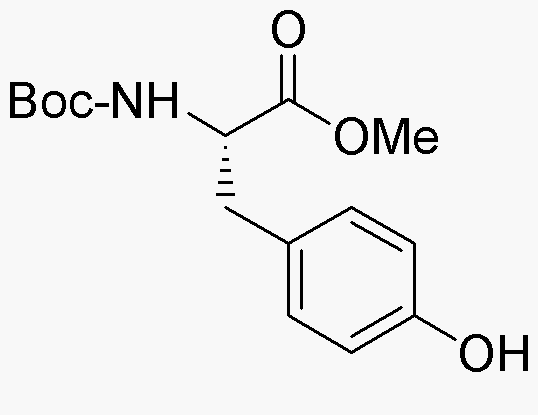Boc-L-tyrosine methyl ester is widely utilized in research focused on
- Peptide Synthesis: This compound serves as a key building block in the synthesis of peptides, particularly in solid-phase peptide synthesis, allowing for the incorporation of tyrosine residues in various therapeutic peptides.
- Drug Development: It plays a significant role in the pharmaceutical industry for developing new drugs, especially those targeting neurological disorders, due to its structural similarity to neurotransmitters.
- Bioconjugation: The compound is used in bioconjugation techniques to attach biomolecules to surfaces or other molecules, enhancing the efficacy of drug delivery systems.
- Research in Cancer Therapy: Researchers utilize Boc-L-tyrosine methyl ester in studies aimed at developing targeted cancer therapies, as it can modify the properties of compounds to improve their selectivity and potency against cancer cells.
- Protein Labeling: It is beneficial for labeling proteins in various biochemical assays, aiding in the tracking and analysis of protein interactions and functions in cellular processes.
Informations générales
Propriétés
Sécurité et réglementation
Applications
Boc-L-tyrosine methyl ester is widely utilized in research focused on
- Peptide Synthesis: This compound serves as a key building block in the synthesis of peptides, particularly in solid-phase peptide synthesis, allowing for the incorporation of tyrosine residues in various therapeutic peptides.
- Drug Development: It plays a significant role in the pharmaceutical industry for developing new drugs, especially those targeting neurological disorders, due to its structural similarity to neurotransmitters.
- Bioconjugation: The compound is used in bioconjugation techniques to attach biomolecules to surfaces or other molecules, enhancing the efficacy of drug delivery systems.
- Research in Cancer Therapy: Researchers utilize Boc-L-tyrosine methyl ester in studies aimed at developing targeted cancer therapies, as it can modify the properties of compounds to improve their selectivity and potency against cancer cells.
- Protein Labeling: It is beneficial for labeling proteins in various biochemical assays, aiding in the tracking and analysis of protein interactions and functions in cellular processes.
Documents
Fiches de données de sécurité (FDS)
La FDS fournit des informations de sécurité complètes sur la manipulation, le stockage et l’élimination du produit.
Spécifications du produit (PS)
Le PS fournit une description complète des propriétés du produit, notamment sa composition chimique, son état physique, sa pureté et les exigences de stockage. Il détaille également les plages de qualité acceptables et les applications prévues du produit.
Certificats d'analyse (COA)
Recherchez des certificats d'analyse (COA) en saisissant le numéro de lot du produit. Les numéros de lot et de lot se trouvent sur l'étiquette d'un produit, après les mots « Lot » ou « Lot de fabrication ».
Numéro de catalogue
Numéro de lot/série
Certificats d'origine (COO)
Ce certificat d'exploitation confirme le pays dans lequel le produit a été fabriqué, et détaille également les matériaux et composants utilisés et s'il est issu de sources naturelles, synthétiques ou autres sources spécifiques. Ce certificat peut être requis pour les douanes, le commerce et la conformité réglementaire.
Numéro de catalogue
Numéro de lot/série
Fiches de données de sécurité (FDS)
La FDS fournit des informations de sécurité complètes sur la manipulation, le stockage et l’élimination du produit.
DownloadSpécifications du produit (PS)
Le PS fournit une description complète des propriétés du produit, notamment sa composition chimique, son état physique, sa pureté et les exigences de stockage. Il détaille également les plages de qualité acceptables et les applications prévues du produit.
DownloadCertificats d'analyse (COA)
Recherchez des certificats d'analyse (COA) en saisissant le numéro de lot du produit. Les numéros de lot et de lot se trouvent sur l'étiquette d'un produit, après les mots « Lot » ou « Lot de fabrication ».
Numéro de catalogue
Numéro de lot/série
Certificats d'origine (COO)
Ce certificat d'exploitation confirme le pays dans lequel le produit a été fabriqué, et détaille également les matériaux et composants utilisés et s'il est issu de sources naturelles, synthétiques ou autres sources spécifiques. Ce certificat peut être requis pour les douanes, le commerce et la conformité réglementaire.


